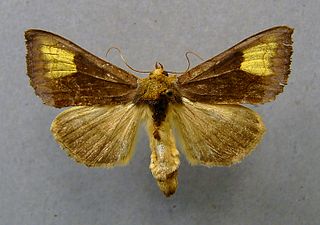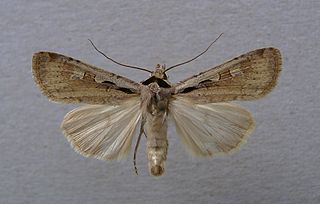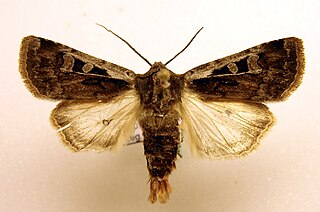
The poplar grey is a moth of the family Noctuidae. It is found throughout Europe.

Acronicta cuspis, the large dagger, is a moth of the family Noctuidae. It is distributed through most of Europe, Northern Africa (Morocco), the European part of Russia, the Caucasus, the Russian Far East, southern Siberia, Transcaucasia, central Asia, China, Japan and the Korean Peninsula.

Diachrysia chrysitis, the burnished brass, is a species of moth of the family Noctuidae. It is found in Europe, the Caucasus, Russia, Russian Far East and Siberia. In the south of Europe the range extends to southern Spain, southern Italy and the Balkan peninsula. It is lacking on most of the Greek Islands. In the north it extends into almost to the Arctic circle and far north Russia. In the east the range extends to the Amur region and Japan.

Parascotia fuliginaria, the waved black, is a species of moth of the family Erebidae. It is found in Europe as far east as the Ural Mountains, in Armenia and Asia Minor, and is an introduced species in North America.

Diachrysia chryson, the scarce burnished brass, is a moth of the family Noctuidae. The species was first described by Eugen Johann Christoph Esper in 1789. It is found in central and southern Europe, Asia Minor across the Palearctic to Japan.

Diachrysia zosimi is a species of moth of the family Noctuidae. It is found in Eastern Europe and bordering regions, such as Poland, Northern Italy, Bulgaria, Ukraine, and Southern Siberia.

The green-brindled dot is a species of moth of the family Noctuidae. It is found in Southern Europe and the Middle East, then east up to Iran and Ukraine. In Germany it is found up to the Eifel and Ahr.

Dichagyris flammatra, the black collar, is a moth of the family Noctuidae. The species was first described by Michael Denis and Ignaz Schiffermüller in 1775. It is found in central and southern Europe, Morocco, Algeria, Egypt, western Siberia, Armenia, the Caucasus, Turkey, Lebanon, Syria, Iraq, Iran, Tibet, Afghanistan and northern India.

Hadena silenes is a species of moth of the family Noctuidae. It is found in Europe, Turkey, Israel, Iran and Turkmenistan.
Chersotis elegans is a moth of the family Noctuidae. It is found in the mountains of Spain, Greece, Turkey, the Caucasus, Lebanon, Israel and western central Asia.

The pale stigma is a moth of the family Noctuidae. It is found in central and southern Europe, Turkey, the Caucasus, Armenia, Kazakhstan and from western Siberia to the Altai.

Coenophila subrosea, the rosy marsh moth, is a moth of the family Noctuidae. The species was first described by James Francis Stephens in 1829. It is found from southern Great Britain, Italy and France, through central Europe north to Scandinavia, east to Russia, from Siberia to the Amur region, Ussuri and Sakhalin, south to northern China, east to Korea and northern Japan.

Euxoa aquilina is a moth of the family Noctuidae. It is found in the Mediterranean region of Europe, North Africa, the Near East and the Middle East.

Euxoa culminicola is a moth of the family Noctuidae. It is found in the Alps and Pyrenees in Austria, France, Italy, Spain and Switzerland.

Dichagyris celsicola is a moth of the family Noctuidae. It is found in Greece, France, Italy and Turkey. It might also be present in Iran and Iraq.

Euxoa vitta is a moth of the family Noctuidae. It is found in central and southern Europe.

Athetis pallustris, the marsh moth, is a moth of the family Noctuidae. It is found in most of Europe, the southern Urals, southern Russia, Ukraine, eastern Turkey, Siberia, the Amur region, the Russian Far East, Mongolia and northern China.

Chersotis larixia is a moth of the family Noctuidae. It is found in Spain, France, Switzerland, Italy and Sicily, Crete, Turkey, and east to Armenia, Azerbaijan, Syria, Iran, Lebanon, and Turkmenistan. In Europe, it is found in mountainous regions, like the Pyrenees, the Alps, and the Maritime Alps, up to heights of 2,000 meters.

Eugraphe sigma is a moth of the family Noctuidae. It is found from most of Europe to the Ural, Siberia, Transcaucasia, Armenia and Korea.

Cryphia fraudatricula is a species of moth belonging to the family Noctuidae.




















